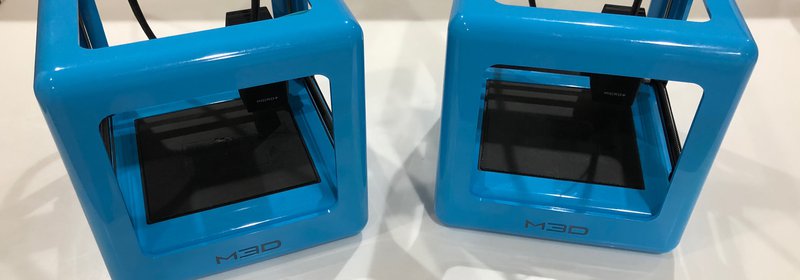
3D Printing Comes to Camp Infinity
Camp Infinity is pleased to announce it has purchased two Micro M3D printers for camp. We will use the printers, among other things, to create a three-dimensional puzzle that the campers take home.
Article Header
« Return to Main Page3D Printing Comes to Camp Infinity
Camp Infinity is pleased to announce it has purchased two Micro M3D printers for camp. We will use the printers, among other things, to create a three-dimensional puzzle that the campers take home.
Camp Infinity is constantly evaluating the latest technology in an effort to discern when it is appropriate to add something new to our summer STEM camps. This allows the camp to stay on the leading edge. However, the most important goal, as with everything at Camp Infinity, is to prepare campers to excel in their STEM related fields and do so with a biblical viewpoint. To this end, the past summer Camp Infinity is pleased to announce it has purchased two Micro M3D printers for camp. We will use the printers, among other things, to create a three-dimensional puzzle that the campers take home. More 3D printer activities are being planned for the future. For this article, we will be giving a brief overview of what 3D printing is for those who are new, where it comes from, and how it is currently used in the job world.
What is 3D Printing, and where does it come from?
While considered by many to be a new technology, 3D printing has actually been around since the 1980’s. The current process used by most 3D printers was invented in 1986 by a man named Chuck Hull. Hull’s printer “was the first ever device of its kind to print a real physical part from a digital (computer generated) file” (Flynt, “A Detailed History of 3D Printing”). It was a game changer. So how does it work?
 3D printing takes a three-dimensional model on a computer screen and builds it in the real world by a process called Additive Manufacturing. While that sounds complex (and it is), the overall idea is very simple. To create something, the printer simply adds layers and layers of material on top of each other like a cake. This is the key concept of 3D printing. By the way, while printing material is often some form of plastic, it can also be metal or even fiberglass!
3D printing takes a three-dimensional model on a computer screen and builds it in the real world by a process called Additive Manufacturing. While that sounds complex (and it is), the overall idea is very simple. To create something, the printer simply adds layers and layers of material on top of each other like a cake. This is the key concept of 3D printing. By the way, while printing material is often some form of plastic, it can also be metal or even fiberglass!
What can 3D Printing do and how is it being used now?
3D printing has applications in almost every field of STEM and business. Here are a few potential examples from several different innovators:
• 3D Printed Organs: “Using 3D printing, Dr. Anthony Atala at Wake Forest's Regenerative Medicine department was able to create artificial scaffolds in the shape of an organ with living cells” (Chowdhry, “What Can 3D Printing Do? Here Are 6 Creative Examples”). This new research has tremendous potential to help the growing list of people who need organ transplants.
• 3D Printing on the International Space Station: “In 2014, the NASA did what they called the Zero G experiment, with Made in Space. Thanks to the 3D printer they made for the International Space Station, astronauts are able to 3D print objects by themselves” (Gaget, “3D Printing in Space: The next Revolution?”).
• 3D Printing Racecars: “British Formula One motor racing company Williams F1 uses 3D printing to create some of the parts in its racing cars, as well as creating parts for models for testing in wind tunnels. The technology shortens the timescale of parts development, with the ability to give a quicker response on how well features work” (Williams, “The Ways 3D Printing Is Being Used”).
In all this, we must remember why we create things like 3D printers in the first place. We ourselves have been created by a masterful Creator (who didn’t need a 3D printer) and seek to be like Him. It is a part of being made in God’s image. Humanity loves to make. By creating and then using our creations for God’s glory, we emanate Him. 3D printing is a rapidly advancing field with a bright future. Camp Infinity’s hope is that the edition of the new printers will give our campers new experiences and opportunities that will grow them to be more like their Maker, Jesus.









